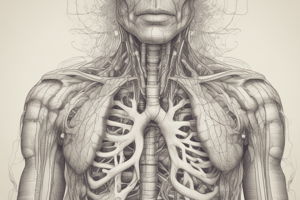Podcast
Questions and Answers
The ______ is a double-layered serous membrane that protects the lungs.
The ______ is a double-layered serous membrane that protects the lungs.
pleura
The ______ divides the nose into left and right sides.
The ______ divides the nose into left and right sides.
nasal septum
The ______ are bony protrusions in the nasal cavity that increase surface area for air filtration.
The ______ are bony protrusions in the nasal cavity that increase surface area for air filtration.
conchae
The ______ are passageways in the nasal cavity.
The ______ are passageways in the nasal cavity.
The ______ is composed of C-shaped cartilage rings.
The ______ is composed of C-shaped cartilage rings.
The ______ are larger airways branching from the trachea.
The ______ are larger airways branching from the trachea.
The ______ are smaller airways that further divide within the lungs.
The ______ are smaller airways that further divide within the lungs.
The ______ are the primary sites of gas exchange in the lungs.
The ______ are the primary sites of gas exchange in the lungs.
The ______ is the breathing process, involving inhalation and exhalation.
The ______ is the breathing process, involving inhalation and exhalation.
The ______ is the main muscle involved in inhalation.
The ______ is the main muscle involved in inhalation.
Flashcards
Major Organs of Respiration
Major Organs of Respiration
Nose, pharynx, larynx, trachea, bronchi, bronchioles, lungs, alveoli.
Pleura
Pleura
Double-layered membrane protecting the lungs.
External Respiration
External Respiration
Gas exchange between lungs and blood.
Internal Respiration
Internal Respiration
Signup and view all the flashcards
Boyle's Law
Boyle's Law
Signup and view all the flashcards
Dalton's Law
Dalton's Law
Signup and view all the flashcards
Inhalation Mechanics
Inhalation Mechanics
Signup and view all the flashcards
Exhalation
Exhalation
Signup and view all the flashcards
Gas Transport of Oxygen
Gas Transport of Oxygen
Signup and view all the flashcards
Chemoreceptors
Chemoreceptors
Signup and view all the flashcards
Study Notes
Respiratory System Components
- Main organs include nose, pharynx, larynx, trachea, bronchi, bronchioles, lungs, and alveoli.
- Protective structure: pleura (double-layered membrane around lungs).
- Nasal features: nasal septum (divides nose), conchae (bony protrusions), and meatus (passages).
- Airways: trachea (C-shaped cartilage rings), bronchi (large airways), bronchioles (smaller airways).
- Lungs are spongy organs divided into lobes, containing bronchial tree and alveoli (site of gas exchange).
Respiration Process - Types
- External respiration: gas exchange between lungs and blood.
- Internal respiration: gas exchange between blood and tissues.
- Pulmonary ventilation: breathing process (inhalation and exhalation).
Gas Exchange Mechanisms
- Boyle's Law: change in container size affects pressure, inversely.
- Air moves from high to low pressure.
- Diffusion follows Dalton's and Henry's Laws.
- Dalton's Law: each gas in a mixture has its own partial pressure.
- Henry's Law: gas solubility in liquid proportional to partial pressure and solubility.
Breathing Mechanics - Inhalation
- Primary muscles: diaphragm and external intercostals.
- Diaphragm contraction increases thoracic cavity space.
- Lung expansion decreases pressure, drawing air in.
Breathing Mechanics - Exhalation
- Normal exhalation: passive, due to elastic recoil/relaxation.
- No muscle use during quiet breathing.
- Pressure increases as thoracic cavity decreases, forcing air out.
Gas Transport - Oxygen
- 98.5% bound to hemoglobin.
- 1.5% dissolved in plasma.
Gas Transport - Carbon Dioxide
- 7% dissolved in plasma.
- 23% bound to hemoglobin.
- 70% as bicarbonate ions.
Respiratory Control
- Brain Centers:
- Medullary respiratory center: controls basic rhythm.
- Pontine respiratory center: modifies breathing (exercise, speech).
- Cerebral cortex: voluntary breathing control.
- Hypothalamus, limbic system: emotional influence on breathing.
Regulatory Mechanisms
- Chemoreceptors: monitor oxygen, carbon dioxide, and hydrogen levels.
- Central and peripheral chemoreceptors respond to chemical changes.
- Inflation/Hering-Brewer reflex prevents over-inflation.
- Proprioceptors in muscles, tendons, and joints also regulate breathing.
Supporting Structures and Functions
- Type 1 cells: gas exchange, alveolar wall structure.
- Type 2 cells: produce alveolar fluid and surfactant.
- Surfactant: reduces surface tension, prevents collapse.
- Compliance: ease of lung/thoracic expansion.
- Patency: airway clearance maintained by cartilage, smooth muscle, surfactant.
Factors Affecting Ventilation
- Surface tension.
- Airway resistance.
- Lung compliance.
- Response from cerebrospinal fluid changes.
- Monitoring by aortic and carotid bodies.
Studying That Suits You
Use AI to generate personalized quizzes and flashcards to suit your learning preferences.




